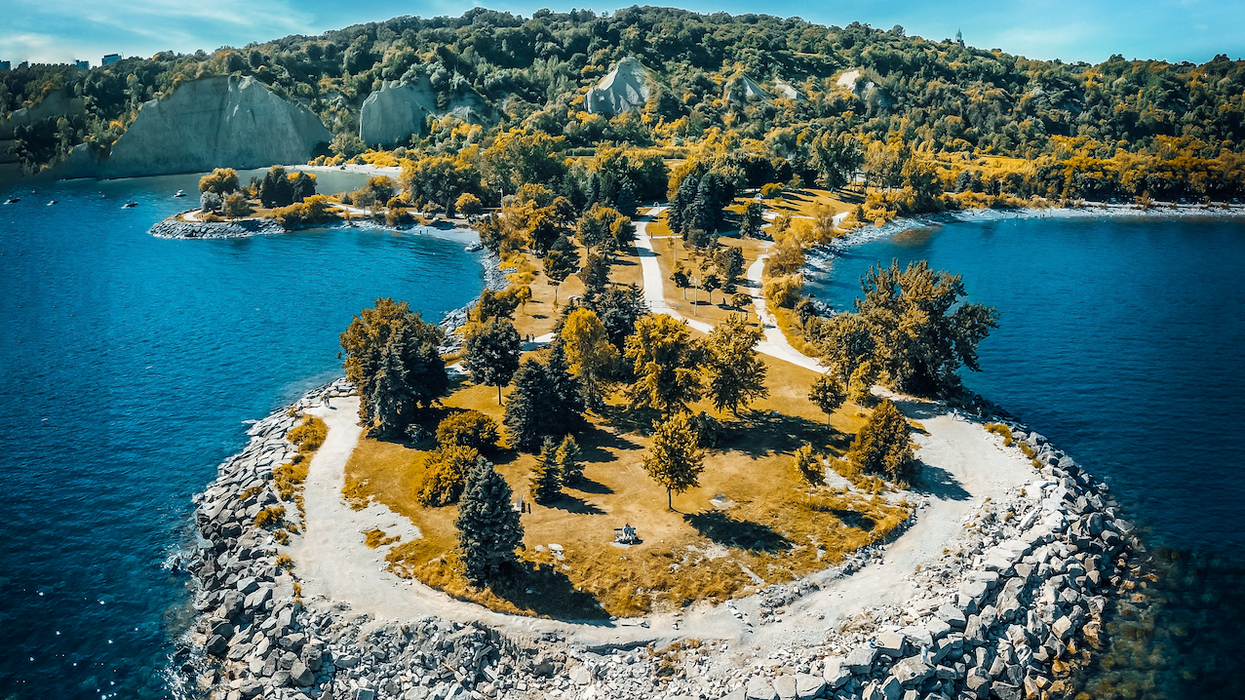Scarborough Bluffs — the hulking, crumbling, breathtaking figure looming over a stretch of Lake Ontario’s northern shore.
Down at the water’s edge, Bluffer’s Park is beloved for its sandy beaches and year-round floating homes. But the cliffs are many things to many people: a remarkable ecological phenomenon, a dangerous trap for hill climbers, a disappearing cliff rich with fossils, a window into our past.
Here are five fascinating facts about the Scarborough Bluffs:
The edges of the Bluffs are dangerous, rapidly eroding, and wayward hikers regularly need to be rescued.
The first words that greet you on the city’s page for the Scarborough Bluffs are a warning — stay away from the edge, it is “unstable.” And that edge is actually eroding as much as 1 metre per year, according to some reports.
But that danger — and hefty trespassing fines — don’t seem enough to stop people from climbing up, or down, the Bluffs. Just google “Scarborough Bluffs rescue” and you’ll see the regular stream of news items. In May, Mayor John Tory even floated the idea of passing on rescue costs to these adventure-seeking climbers.
READ: 8 Toronto Neighbourhoods Nature Lovers Won’t Be Able To Resist
You’re probably thinking: selfies. But getting trapped on the Bluffs has been going on for generations.
One news item from 1972, courtesy of the Toronto Reference Library’s archives, describes a young girl nursing a mangled hand after an attempt to rescue her two girlfriends, trapped on the steep cliffs. The girl slid 150 feet down the Bluffs, grabbing at branches in an attempt to slow her fall.
The Bluffs are the former shoreline of an ancient glacial lake — marking the end of the Great Ice Age.
The steep drop of the cliffs were carved by Lake Iroquois, whose water levels were pushed high by an ice-dammed St. Lawrence River. When this ice dam melted and collapsed, Lake Iroquois’s levels dropped sharply away, leaving the Bluffs towering above present-day Lake Ontario — roughly 30 metres lower.
The sediment contains fossilized plants and animals, and upper layers show the advance and retreat of ice over time. Says a city plaque on the site: “The layers of sand and clay exposed in these cliffs display a remarkable geological record of the last stages of the Great Ice Age. Unique in North America, they have attracted worldwide scientific interest.”
The eroding cliffs formed the Toronto Islands.
Do you fly Porter? Have you spent a summer afternoon on Centre Island?
Even if you’ve never been to the Bluffs, you still may have enjoyed its popular, younger siblings — the Toronto Islands. “Millions of tons of sand” from the cliffs formed the islands as we know them today.
Countless ships have sunk along the Bluffs, and locals collected bits of wreckage and smuggled goods.
Jane Fairburn’s 2013 book, Along the Shore, explores the fascinating history of Toronto’s waterfront, including the famous Bluffs in the east. She’s also a long-time resident.
Fairburn describes an early pioneer culture that revolved around the ship trade and shipping, including smuggling goods to avoid taxes. Locals would often take a boat to get to York instead of using roads, she says. But the coast was dangerous, particularly during storms.
“During the 19th century, it’s fair to say that many ships foundered off the coast of the Scarborough shore,” she says. “I don’t know (how many died) but there was certainly a lot of goods lost — pilfered.”
READ: Life On A Floating Home In Toronto (Can Be Less Expensive Than A Detached House)
One of the book’s chapters describes the sinking of the Alexandria in 1915 and its dramatic rescue efforts. All men aboard were saved by the “brawny Ed Middleton” who tied a rope around his waist and waded out to a capsized lifeboat.
The ship’s lost cargo was quickly snapped up by locals and many families kept a memento of the ship wreckage — Fairburn says an enormous anchor on a neighbour’s front lawn is rumoured to be from the Alexandria.
As she writes in her book: “Today what is left of her rests within twenty or thirty feet of shore. Her boiler is out there still and may be seen at periods of low water every summer, sticking up out of the blue.”
There are rumours of treasure.
Considering its storied past of shipwrecks and smuggling, the Bluffs are bound to be the keeper of secrets.
“In the 19th century, there are many accounts of treasure being hidden in Gates Gully, and the Highland Creek river valley as well,” Fairburn says. “Stories about treasure go back to the War of 1812 — rumours of it being there and generations of kids searching for it, including some of the old pioneer families.”
Of course, locals would say the Scarborough Bluffs are a treasure in itself. Hikers can find fossils in the earth and Fairburn’s book chronicles exciting archaeological discoveries, some of which are among the oldest in Toronto. Many local families have stayed for generations, she says, seduced by the raw beauty of this dangerous coast.
READ: How Kingston Road Is Rapidly Shaping Up To Be King Again
“Anybody who lives below Kingston Road knows there’s quite a bit of difference being a Torontonian out here,” she says. “The backbone of the community lies in the continuity of the residents and families who have been here since the 19th century.”
“There are very significant pieces left of the natural world that are intact. We not only experience them, but many people out here feel we are the stewards of that natural history that is still alive.
“We live in a world of enchantment down here, we really do.”





















